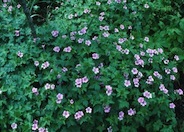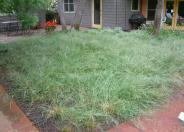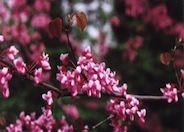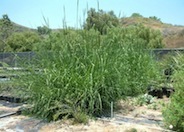
Common name:Boston Ivy
Botanical name:Parthenocissus tricuspidata
This deciduous vine grows leaves that are usually lobed and divided into 3 leaflets. It clings tightly to any surface.

Common name:Dalmation Bellflower
Botanical name:Campanula portenschlagiana
The Dalmation Bellflower is a mounding, deciduous perennial that forms a curtain of purple flowers often blooming in waves throughout the year. It should be grown in areas with sun to partial shade. -Monterey Bay Nursery

Common name:Endress' Cranesbill
Botanical name:Geranium endressi
This handsome tree has near-evergreen leaves which have a long blooming period.

Common name:Sweet Orange cultivars
Botanical name:Citrus sinensis
This tree will grow 20-30' high x 10-15' wide and produces sweet, tasty oranges. It has shiny green, leathery foliage and produces clusters of fragrant white flowers that bloom in the spring.

Common name:Needle Grass
Botanical name:Nassella pulchra
The needle grass is a cool season bunchgrass that grows 1-2 ft. tall with graceful, shiny flower stalks that reach 30 in. long in the spring. This grass is fire retardant, tolerates drought, and is good in mass plantings and restoration uses. The needle grass is California's State Grass and is a beneficial insect plant. -Cornflower Farms

Common name:Eastern Redbud
Botanical name:Cercis canadensis
This small, deciduous tree with a rounded head is covered with small flowers of a rose pink color in the spring before the appearance of heart-shaped leaves. It can grow to 25' tall with an equal spread. It has a low branching habit with a rounded form.
Yellow fall colors.

Common name:Giant Wild Rye
Botanical name:Leymus condensatus
A prominent tall native grass that usually does not make its way into traditional residential landscapes but can be used very effectively in a native or natural garden. Reaches heights of 6-8' in bloom and will clump to 4-5' wide. Requires supplemental water to remain green in the summer. Too much water will cause the grass to decline significantly. Can be pruned annually to promote new, more attractive growth.
Putting the right plants in the right places in the right groupings is both the challenge and art of good landscape design.
Click in the green box for more information
Designer: Connie Lefkowits
Photographer: GardenSoft
Physical weed control, including mulching, or hand removal protects the watershed from harmful chemicals.
Drip and other smart irrigation delivers water directly to roots, allowing no excess water for weeds.